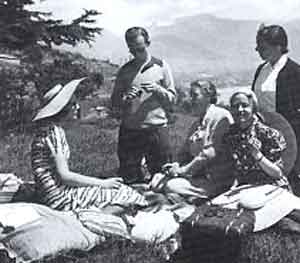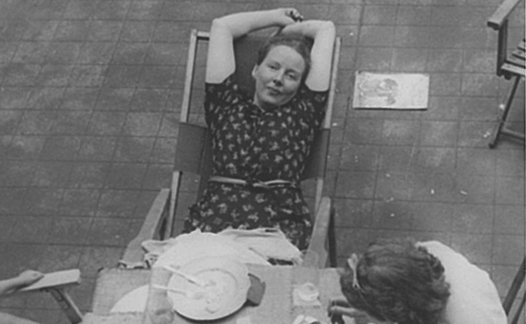Fisher sets rules for picnics in stone. In “The Pleasures of Picnics,” she declares people who do not like picnics must be “dismissed immediately.”
Fisher’s “true” picnic (and maybe yours?) must be outdoors and away from home. “It can consist of a piece of bread and an apple, eaten anywhere in the outdoors that will make it taste good,” she argues, “but it is not, strictly speaking, a picnic if it is on a terrace or in a patio, or under the linden tree in the backyard.” Humorous perverse, she says a picnic should have hazards like ants, rough ground, etc. Nevertheless, she insists that unless picnickers are jolly, the picnic will fail. Ants be damned!

Picnic at La Pâquis [With Norah Kennedy (sister), David Kennedy (brother), Mary Powers (friend), Anne Parrish (Timmy’s sister), and Mary Frances. In M.F.K. Fisher. A Life in Letters: Correspondence 1929-1991.
According to Fisher’s scheduling, the best times for picnicking are April, May, Midsummer (?), and October. The rest of the year is ruled out. Hmmm.
Featured Image: The meadow at La Pâquis, Dillwyn “Timmy” Parrish’s house, near Vevey (1938). Fisher is seated behind the wicker (contents unknown). It was also a trysting place because she was having an affair with Parrish.
See M. F. K. “The Pleasures of Picnics,” In A Stew or a Story: An Assortment of Short Works by M.F.K. Fisher, edited by Joan Reardon. Emeryville, CA: Shoemaker & Hoard, 2006; originally Harper’s Bazaar (1957); M.F.K. Fisher. Stay Me, Oh Comfort Me: Journals and Stories 1933–1941. New York: Pantheon, 1993; Joan Reardon. Poet of the Appetites: The Lives of M.F.K. Fisher. New York, North Point Press, 2004; Anne Zimmermann. An Extravagant Hunger: The Passionate Years of M.F.K. Fisher. Washington, D.C: Counterpoint, 2011; M.F.K. Fisher. A Life in Letters: Correspondence 1929-1991. Selected by Norah K. Barr, Marsha Moran, and Patrick Moran. Washington, D.C.: Counterpoint, 1997.
* Fisher’s favorite sandwich, “the railroad,” is a simple version of the pressed sandwich, similar to the entry in Auguste Escoffier’s The Complete Guide to the Modern Art of Cookery (1903). The recipe requires a sourdough baguette slathered with sweet butter and filled with slices of ham. Escoffier used a press to flatten the sandwich, but Fisher prefers sitting on it. Some might quibble that the sandwich requires mustard, but not Fisher. Escoffier took the recipe from Alfred Suzanne’s La Cuisine Anglaise (1894), humorously suggesting that it’s the kind liked by racing people that might “in an emergency, answer the purpose of a meal.”

